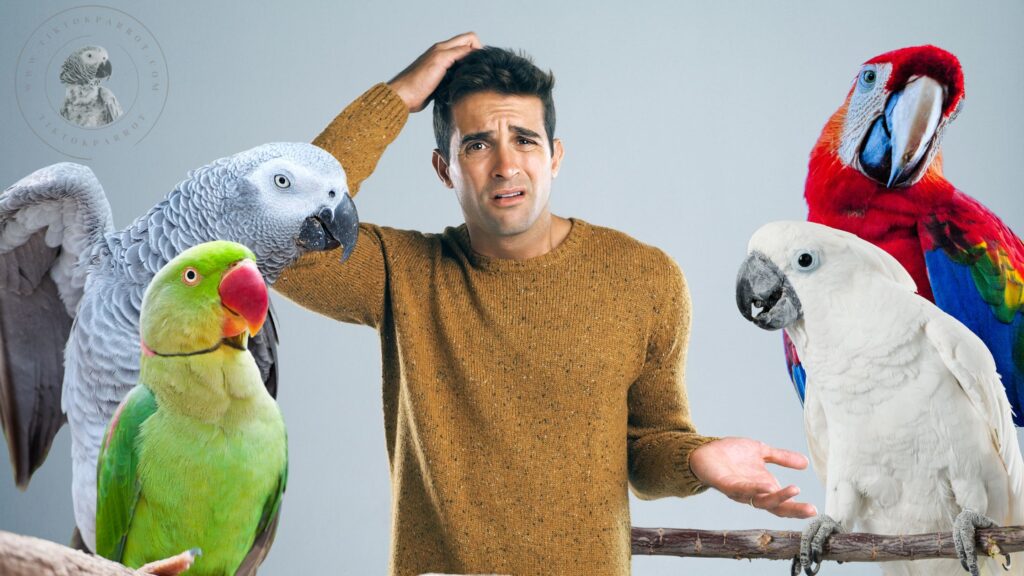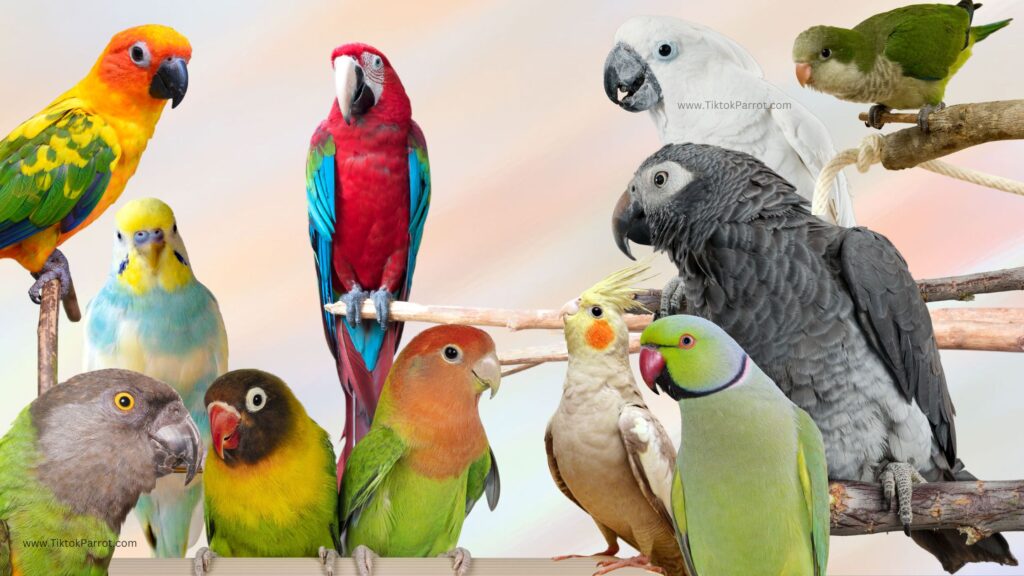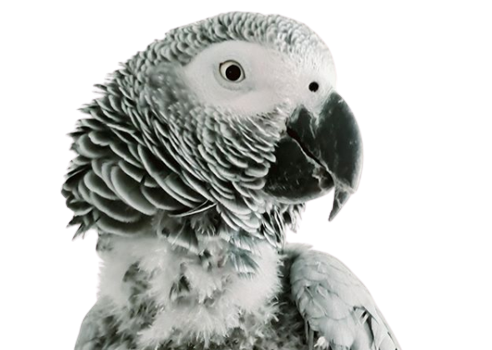So, you’ve been bitten by the bird bug! Thinking about bringing a feathered friend into your life? Well, buckle up, because we’re about to take a whirlwind tour of the coolest pet parrots out there.
First, some fun facts! Did you know Brazil is basically the land of parrots, with about 20 million feathered residents? That’s more beaks than people at a free bread convention! And guess what? The trend is catching on in the US, thanks in part to our friends from Latin America who love their chatty companions.
Now, with over 350 parrot species, choosing the right one can be trickier than untangling Christmas lights. But fear not, my friend! We’ll explore some of the most popular parrots, from the chatterbox African Grey to the cuddly lovebird.

No matter which parrot you pick, they all need some basic things to be happy: a roomy cage (think personal high-rise, not shoebox), healthy food, and some toys to keep them from getting bored (goodbye, furniture!). Picking the perfect parrot supplies can be a jungle in itself, so here’s a cheat sheet from the experts:
- Food: Imagine tiny astronaut space food. Not very yummy, right? That’s why vets recommend a mix of colorful pellets and fresh fruits and veggies. Think of it as a birdie salad bar!
- Cages: Your feathered friend needs room to stretch those wings. For small and medium parrots, a cage the size of a mini refrigerator should do the trick. For the bigger guys, think walk-in closet (well, maybe not that big, but definitely roomy).
- Toys: Parrots are smart cookies and can get easily bored. Colorful swings, chew toys, and anything that makes a racket will keep them happy and mentally stimulated. Think of it as parrot entertainment – Netflix for birds!
Alright, enough squawking around, let’s meet the feathery stars of the show!
- Parakeet (Budgie): The tiny dancer of the parrot world! These little guys come in a rainbow of colors and are known for mimicking sounds, including human speech (watch out, they might learn your embarrassing karaoke songs!). Budgies are easy to care for, making them a great choice for beginners. Plus, their bites are like little nips compared to bigger birds, perfect for families with kids.
- Lovebirds: These cuddly cuties are like the parrots that come in a pocket-sized package. They’re full of personality, love to play, and can get super affectionate with their favorite humans. Lovebirds come in a variety of colors and are happiest when they have a buddy (so think couples therapy, but with feathers!).
- Cockatiel: This friendly fellow is a great choice for new parrot owners. They’re known for their easygoing personalities and love to chat (although their vocabulary might be a bit more “birb” than Shakespeare). Like budgies and lovebirds, cockatiels need a healthy diet, a spacious cage, and plenty of toys to keep their minds sharp.
- African Grey: African Greys are basically the Einsteins of the parrot world. These sharp cookies are famous for their impressive vocabulary and ability to mimic human speech. They’re even smarter than some kindergartners, solving puzzles and understanding complex concepts. Imagine having a feathered roommate who can hold a conversation (and maybe even help you with your taxes… okay, maybe not that last one).
These brainy birds need a lot of mental stimulation, so get ready to break out the puzzle toys and flashcards (bird trivia night, anyone?). African Greys are also known for being sensitive souls, so be prepared to shower them with love and attention. They’re not the best choice for someone who’s out the door all day. - Cockatoo: Cockatoos are the ultimate social butterflies of the parrot world. These playful goofballs crave constant attention and love to shower their humans with affection (and maybe a few ear-splitting squawks). They’re incredibly loyal and can form strong bonds with their favorite people.
Think of a cockatoo as your personal feathered cheerleader, always up for a good time. Just be warned, these party animals need a LOT of interaction and can get grumpy if left alone for too long. They’re also known for being a little on the noisy side, so earplugs might be a good investment (although their silly antics are pretty darn cute). - Senegal Parrots: Imagine a parrot with a charming personality and a mischievous streak – that’s the Senegal Parrot! These green and grey birds with a splash of color on their bellies love to play and goof around. They can even learn to talk!
They’re happy to be part of the family, but watch out for nips if they’re not in the mood for cuddles. Think of them as playful puppies with feathers – adorable, but with tiny beaks that can pack a punch. Senegal Parrots are best suited for adults or calm households with older kids. - Macaws: Macaws are the rockstars of the parrot world. These giant birds come in stunning colors, from bright blue to fiery scarlet. They have impressive beaks that can crack open coconuts and voices that can be, well, let’s just say they won’t win any singing contests. But what they lack in musicality, they make up for in personality!
Macaws are affectionate and love attention, but they need a lot of it. If you’re a busy bee, a Macaw might get lonely and grumpy. Owning a Macaw is like having a feathered toddler – they’re a big responsibility but bring tons of joy! - Conures: Conures are like mini-macaws, with vibrant feathers in all sorts of colors. But unlike their bigger cousins, they’re perfectly happy in an apartment. These social butterflies love to play and are known for being patient with kids. They’re also adaptable and don’t mind if you work long hours – as long as they get some playtime each day.
Conures are like the easy-going friends of the parrot world – always up for fun, but happy to chill too. - Quaker Parrots: Quaker Parrots are full of personality! These green goofballs are known for their silly antics and love to learn tricks and even talk. They’re surprisingly small, about the size of a soda can, but their energy is larger than life.
Quakers love attention and tend to bond strongly with one person. They’re cuddle bugs and love head scratches – just watch out for those playful nips! Think of them as tiny comedians who love to chat and play. - Indian Ringnecks: Indian Ringnecks are the intelligent and affectionate parrots. These beauties, with their colorful rings around their necks, are quick learners and love to show off their tricks. They crave attention and can become shy or even aggressive if left alone too much.
Think of them as the loyal companions of the parrot world – always happy to see you and ready for some playtime. But remember, a neglected Ringneck can be a grumpy Ringneck! - Alexander the Great of Parakeets: Imagine a parakeet the size of a small breadstick, with a talent for talking that would make even your chatty uncle jealous. That’s the Alexandrine Parakeet for you! Named after the famous Alexander the Great (though probably not as good with a sword), these Indian and Sri Lankan birds are real smarties.
They can learn tricks, show off their impressive flying skills, and even become your best bud, showering you with attention (and maybe a few squawks if you leave them alone too long).
But here’s the thing: these Alexandrines are like teenagers. They go through a hormonal phase where they might puff up their feathers and act tough. So, if you’re a new bird owner, this might not be the feathery friend for you. They also need a big house (cage, that is) and plenty of playtime to keep them happy. - Kakariki: If you’re looking for a smaller parrot with a big personality, then the Kakariki might be your perfect match! These little bundles of joy come straight from New Zealand and look a bit like a green and yellow party hat exploded onto a fluffy green bird.
They’re clever cookies who can learn words, mimic sounds, and even perform tricks (think of them as the feathered Cirque du Soleil).
Kakarikis love attention and playtime, so be prepared to chat with them, teach them silly things, and watch them explore their cage like tiny ninjas. Just like the Alexandrines, they need a good-sized cage with lots of climbing toys to keep them busy.
General Care Tips for Pet Parrots Owners

So you’ve got a new feathered flatmate – congrats! But bringing home a parrot is like adopting a tiny, squawking toddler with a serious grudge against wallpaper. Don’t worry, though, creating a happy life for your chirpy chum isn’t rocket science (although they might appreciate a miniature spaceship toy in their cage).
Here’s the clucking gist: parrots need a comfy home, yummy food, and regular checkups at the vet. Think of it like a recipe for avian awesomeness.
First up, the digs. Imagine being stuck in a tiny closet all day – not fun, right? That’s how a cramped cage feels to a parrot. They need space to spread their wings and climb like they’re auditioning for a swashbuckling bird musical. Plus, a small cage can make them grumpy and prone to feather plucking – basically the avian equivalent of tearing your curtains out of stress.
Next, food! Just like us, parrots need a balanced diet to stay healthy. Skittles for breakfast might seem fun, but it won’t give them the nutrients they need to be bright-eyed and bushy-tailed (or should we say, bright-beaked and bushy-feathered?). Think fruits, veggies, and special parrot pellets – like tiny, colorful cheerios for your chirpy matey.
Finally, vet checkups. Parrots are like ninjas of illness – they hide when they’re not feeling well. By the time they start looking like a moulting pillow, it could be serious. Regular vet visits are like detective work – they help spot any problems before they turn into a feathery fiasco.
So, there you have it! A beakful of tips to keep your feathered friend happy and healthy. Now, go forth and conquer the world of parrot care (and maybe invest in some earplugs – they can get a bit loud!).
Environment and Housing
Imagine living in a shoebox – not exactly fun, right? That’s why your parrot needs a spacious cage where they can spread their wings and climb around. Think “mini-mansion” instead of “jail cell.” Here’s the good news: bigger is always better!
For small birds like budgies and lovebirds, a cage around 18″ x 18″ x 24″ should do the trick. Think of it as a cozy studio apartment. For medium-sized parakeets like cockatiels, aim for a slightly bigger space, like 20″ x 20″ x 24″. They’re like the one-bedroom apartments of the parrot world. For the big guys like macaws, you’ll need a mansion – at least 48″ x 36″ x 60″. Basically, a place where they can fly around and practice their aerobics without bumping their heads.
But it’s not just about size – location matters too! Put the cage somewhere where your parrot can interact with you and the family, but also feel safe and secure. Avoid spots with strong drafts or nasty fumes (no one likes secondhand smoke, not even parrots!). Most importantly, give your feathered friend some playtime outside the cage in a safe, parrot-proofed area. They need to stretch their wings and explore, just like any curious adventurer.
Balanced Diet for Your Parrot
Just like us, parrots gotta eat healthy to live their best squawking life. Out in the wild, they’re like tiny flying gourmets, nibbling on fruits, veggies, seeds, and the occasional creepy crawly (don’t worry, you won’t have to stock crickets!). This all-star menu keeps them fit and fabulous, free from birdie illnesses and that dreaded “chunky parrot” syndrome.
Now, when your feathered friend becomes part of your flock, it’s up to you to be their personal chef. Think of yourself as a tiny-bird food stylist! Toss in a rainbow of fresh fruits and veggies – they’re basically nature’s candy, packed with vitamins that keep your parrot chirpy. Don’t forget some high-quality parrot pellets or seeds, bursting with grains and protein to keep those wings strong.
But here’s the thing, folks – don’t be a seed slinger! Just like you wouldn’t eat chips all day (well, maybe not every day), too many seeds aren’t good for feathered friends. And while we’re on the topic of no-nos, keep that avocado toast and chocolate away from your beak-buddies – it’s toxic for parrots!
The key is variety. Mix things up with different foods to keep your parrot’s taste buds happy and their bodies healthy. Remember, every parrot is different, so a quick search online about what your specific species needs can work wonders.
By creating a balanced birdy menu with a mix of fresh and not-so-fresh goodies, you’re basically setting your parrot up for a long, happy life. Bonus fact: what they eat can affect their mood! A healthy diet means a happy parrot, while a not-so-healthy diet might mean some grumpy squawks. So keep that food bowl colorful and exciting, and your feathered friend will reward you with a lifetime of chirpy companionship (and maybe even a learned trick or two!).
Parrots Regular Health Check-ups
So you’ve got a feathered friend in your life – that’s fantastic! But just like you wouldn’t ignore that nagging cough for weeks (okay, maybe some of us would…), regular checkups at the vet are a must for your parrot too. Think of it like an insurance policy for their tiny bodies – an annual visit can stop little problems from turning into big ones.
Here’s the thing: parrots are like feathered ninjas when it comes to hiding illness. In the wild, showing weakness means becoming lunch for a hungry hawk, so they’re super good at acting all chipper even when they don’t feel great. That’s why by the time we notice something’s wrong, it might be a bit late.
Enter the avian vet – basically a superhero for feathered friends! These amazing vets are all about keeping your parrot in tip-top shape. They do this with checkups and tests, like detective work for birdies. It’s not just about fixing problems, but stopping them before they even start.
Think of it as a chance to chat with a parrot pro about your feathery roommate. What kind of food should they be eating? Is their cage a safe and comfy place to hang out? The vet can answer all your questions and make sure your parrot is living their best, healthiest life.
So don’t be a bystander when it comes to your parrot’s health! Schedule those regular checkups and keep your feathered bud soaring high (and healthy) for years to come.
Mental Stimulation and The Need for Social Interaction
Parrots aren’t like grumpy old hermits who enjoy living alone (unless maybe they’ve had a rough go with a particularly chewy toy). In the wild, these chatty birds are all about hanging out with their feathered buddies, like a giant gossip session in the trees. It’s how they feel safe, happy, and, well, not totally bonkers.
Imagine having to find your own lunch, dodge hungry hawks, and deal with squawking teenagers all by yourself – that’s basically a parrot’s life without a flock. But fear not, fellow bird enthusiast! The good news is, parrots are smart cookies and can totally see you, their awesome human, as part of their crew.
By giving your feathered friend some social TLC, you’re basically becoming their BFF and therapist rolled into one (minus the hefty therapy bills). It’s a win-win! You get a chatty companion, and they get a mentally happy life, just like they would hanging out with their jungle peeps. So next time your parrot squawks for attention, think of it as an invitation to join the coolest flock in town – your living room!
My Closing Thoughts
I would say owning a parrot is a big commitment. These amazing birds can live for decades and require a lot of care and attention. But for the right person, a parrot can be a beloved family member for many years to come. So, before you bring home a feathered friend, make sure you’re ready for the responsibility. With the right knowledge and care, you can create a happy birdie heaven for your new best friend!
If you found this blog helpful, It would be great if you could share it with your family and friends who might find it useful as well.
You might like to read these as well
10 Best Talking Bird Species to Keep as Pets
Types of African Grey Parrots
Surprising facts about African Grey Parrots
The Importance of a Cage for Your African Grey Parrot
New Bird, New Home: A Stress Free Guide Teaching Your Bird
For more useful content about African grey parrots, you can subscribe my site with your email to get notification upon publishing a new blog, the subscribe box you can see on the right side of this page. Also if you get an alert on your web browser while browsing my site, allow it and that will also give you an alert whenever I publish a new blog.
Stay safe and much love!



